Leaders focus on driving progress, hitting ambitious goals, and delivering results. But in the pursuit of these challenges, one piece can get overlooked: the growth and development of the people who make it all possible.

I’ve been there myself. I trusted my instincts to spot people’s strengths and potential, and help them grow and excel in their work. It worked — for a while. But as the team expanded, I realized that intuition alone wasn’t enough.
Questions started to surface like:
These gaps in clarity — both from my team and from new candidates — highlighted a critical need for structure.
What was missing? A competency matrix — a clear, objective framework to define roles, responsibilities, and growth paths. This article unpacks what a competency matrix is, including its benefits, how to make and use one, and practical tips for its implementation.
A competency matrix is a structured framework organizations use to evaluate, align, and map skills across different roles. It’s used to provide clarity and consistency for internal and external profiling.
A competency matrix is typically tailored to a specific job family.
For instance, a product manager (PM) competency matrix outlines the expectations, skills, and expertise needed across the product management job family. It pictures the career progression within the organization from entry-level PM positions, such as associate product manager, to the most senior levels, such as chief product officer.
A competency matrix brings structure and clarity to hiring, performance evaluations, and career development:
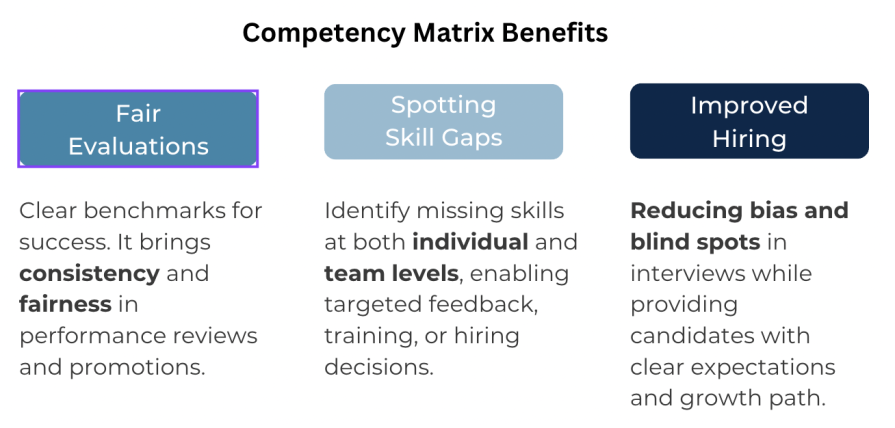
While valuable for any role, a matrix is especially useful for product management, where responsibilities can vary widely across organizations.
Here’s a step-by-step process to create a competency matrix:
What are the job families for your team? What are the progression levels for each of them?
Here are some examples of job families and their seniority levels:
The next step is to identify the core competencies required within a job family.
A competency is more than just a skill — it’s a combination of knowledge, skills, abilities, and behaviors needed to perform a role effectively.
While skills are more specific, often technical and task-oriented, competencies are broader and focus on how those skills are applied in a real business context. For example, using roadmapping tools is a skill, but product strategy and roadmapping is a competency.
Don’t rush to create the list of competencies. It should be a thoughtful process. Collaborate with other stakeholders and think about:
Allow room for flexibility and iteration as your team evolves. If you review it in a few weeks, you’ll likely spot points to improve.
Here’s an example of eight competencies for the product management job family, classified in four categories: Strategy, people, process, and product:
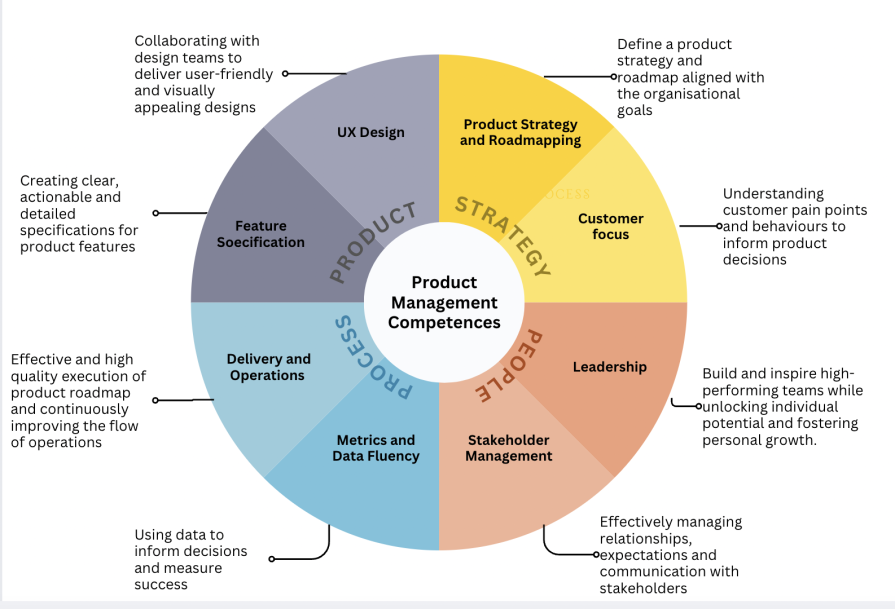
Some competencies, like product strategy and roadmapping, are unique to the product management job family. Others, such as leadership and stakeholder management, are more universal and apply across multiple job families, including both product management and engineering.
Now you can create the competency matrix, detailing the responsibilities and proficiency levels required for each competency across different seniority levels:
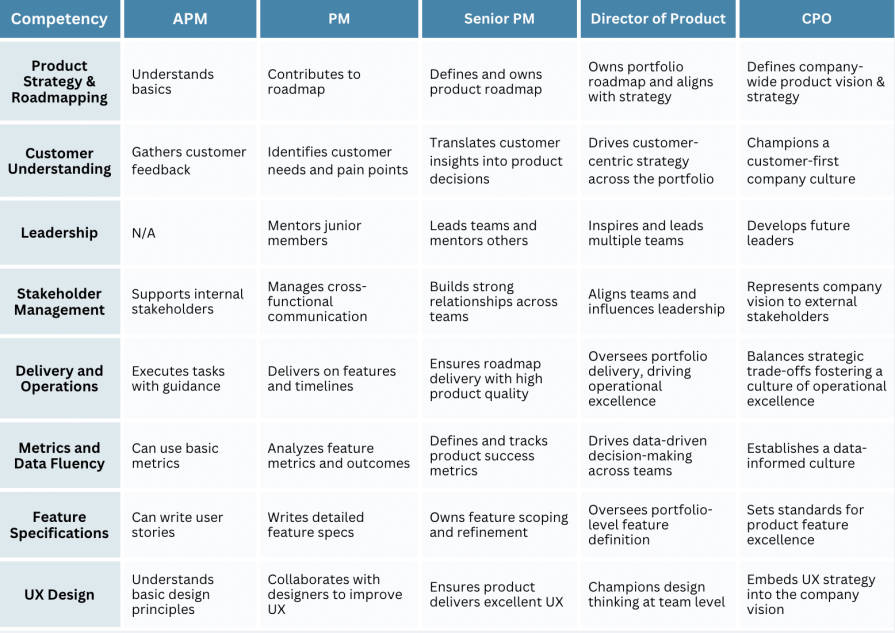
Now that you have the competency matrix, here’s how to put it to work effectively:
Most organizations already have a process for performance evaluation and development. Integrate the competency matrix in the existing process to make it more actionable and focused.
Map each individual to the matrix. Assess where they currently stand:
Bring these insights into your next 1on1 meeting. The key is to have an open discussion and listen to your team member’s perspective. Agreement on the next steps for improvement is critical. Without buy-in, the matrix risks becoming just another formal document with little real impact.
The competency matrix isn’t just for individual growth — it’s also a tool to identify gaps at the team level.
Try mapping your current team’s skills and competencies to the matrix:
Use these insights to address gaps. Consider targeted training, mentoring, or hiring for new roles.
Before your next interview, revisit the competency matrix. It’s a great way to focus on the key areas that truly matter for the role.
After the interview, map the candidate to the matrix:
The matrix brings structure, fairness, and consistency to the hiring process.
And when candidates ask, “How can I grow in this role?” — you’ll have a clear, compelling answer. You can outline growth paths, set expectations, and demonstrate that you care about people’s development.
When I recently introduced a new role to fill gaps on my team, I knew it would be a challenge. This wasn’t just any position — it was a highly collaborative role that would touch multiple teams across the organization. Naturally, stakeholders from different departments were involved in the hiring process and eager to have their say.
The process took longer than expected. Finding the right fit wasn’t easy, but there was also another challenge we discovered: Lack of clarity and misalignment. Each stakeholder had a different perspective on the role’s responsibilities and contributions.
This created confusion — not just for us but for the candidates as well — and ultimately was slowing everything down.
We introduced a competency matrix. Developing the matrix forced us to revisit the key requirements for the role, clarify the competencies required, and formalize the growth potential of this role.
The result?
Used the right way, the competency matrix can bring a lot of value. But if you treat it as a “check-the-box” task, its value quickly fades.
Keep it relevant, actionable, and impactful with these practical tips:
The matrix is a tool—not a rigid rulebook. Respect people’s unique talents and profiles.
Exceptional candidates and team members often don’t check all boxes but they have exceptional unique skills that can bring immense value.
Use the matrix to guide decisions, not to limit them.
Your teams evolve, your company grows, and your priorities shift. Review the matrix periodically to keep it relevant. Every iteration allows you to see things with fresh eyes and improve it further.
A good rule of thumb?
Revisit it when new roles are introduced, teams expand, or the business changes direction.
Collaborate with relevant stakeholders.
For competencies that overlap across job families or teams — like leadership or stakeholder management — make sure requirements are aligned. While expectations for roles differ, basic ground rules should apply across the organization.
For example, leading a team of engineers should compare reasonably to leading a team of designers or analysts.
Every company is unique, but benchmarking against industry practices keeps your matrix grounded.
Is your “director of product” role in line with similar companies at your scale?
Follow the trends and use the language understandable for both internal and external hires.
It’s a good approach to make the matrix accessible to team members. They would know what’s expected and how to grow.
Plus, you can get valuable feedback from the team — it’s a chance to refine the matrix and ensure it stays valuable.
The matrix is quite simple, so there’s no need to use any advanced tooling.
Excel, Google Sheets, Miro, or Confluence, anything works perfectly well.
Choose what’s already accepted and familiar in your organization. Most important is to ensure adoption of the tool.
A structured approach to people development signals maturity and professionalism. If you’ve relied on gut feeling only when hiring or promoting, introducing a competency matrix can make a difference. It brings clarity for you, clarity for your team, and clarity for new hires.
That said, use the matrix as a guide, not a rulebook.
Exceptional people don’t fit into predefined boxes — their strengths and weaknesses are unique. This is what sets them apart.
Keep room for flexibility and let your talent shine.
Featured image source: IconScout
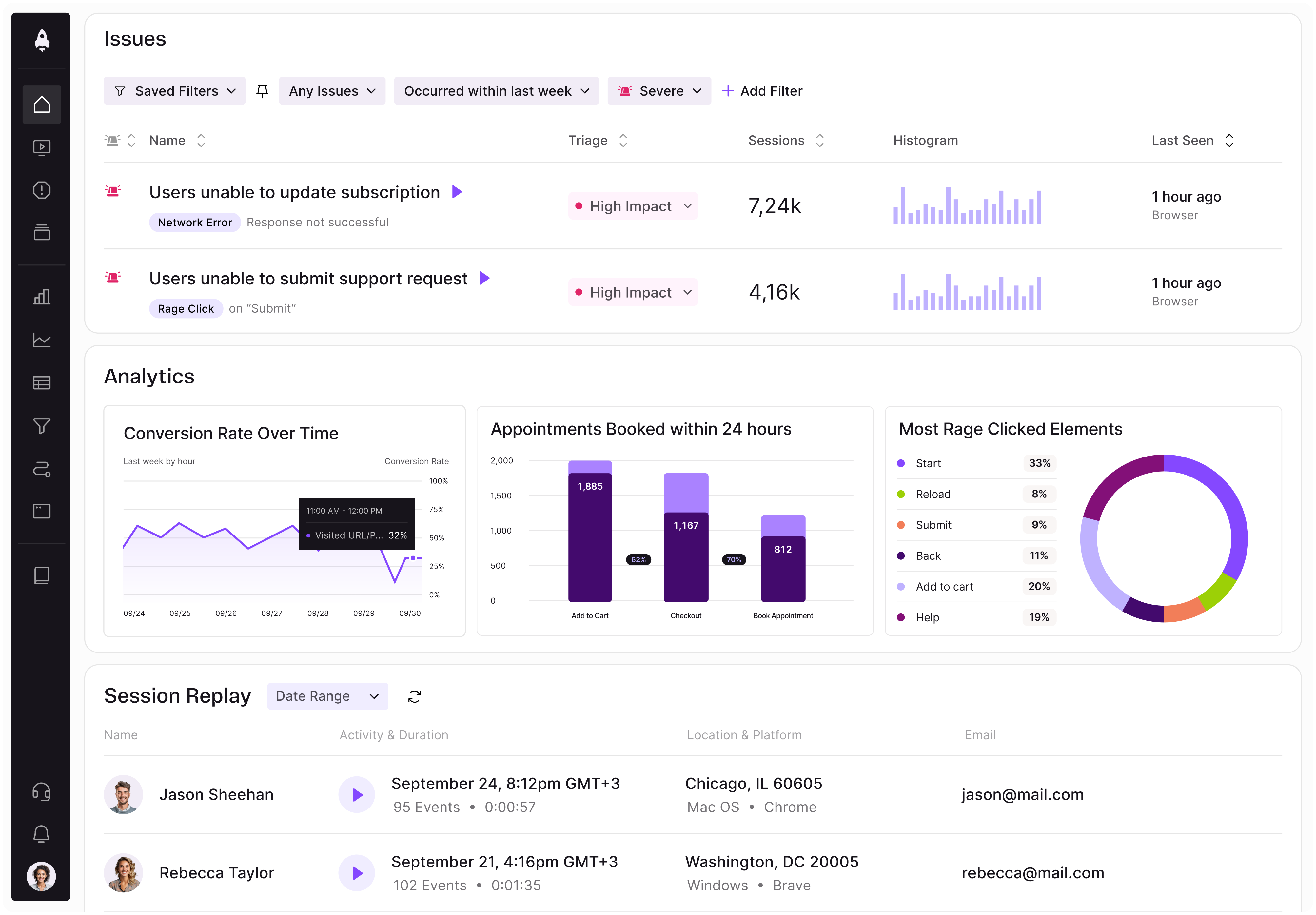
LogRocket identifies friction points in the user experience so you can make informed decisions about product and design changes that must happen to hit your goals.
With LogRocket, you can understand the scope of the issues affecting your product and prioritize the changes that need to be made. LogRocket simplifies workflows by allowing Engineering, Product, UX, and Design teams to work from the same data as you, eliminating any confusion about what needs to be done.
Get your teams on the same page — try LogRocket today.

A practical five minute revenue estimation method to help product managers compare ideas, drop low impact features, and prioritize smarter.

A practical guide for PMs who want to stop being bottlenecks, delegate smarter, and lead teams effectively with a clear ownership framework.

Stop letting unreliable data block features. Treat data as inventory to track quality, ownership, and ship with confidence.
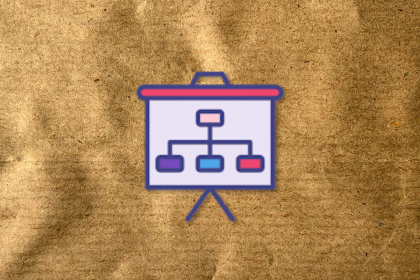
Learn why slide decks slow teams down and explore better tools like whiteboards, PRDs, and prototypes to improve collaboration and alignment.